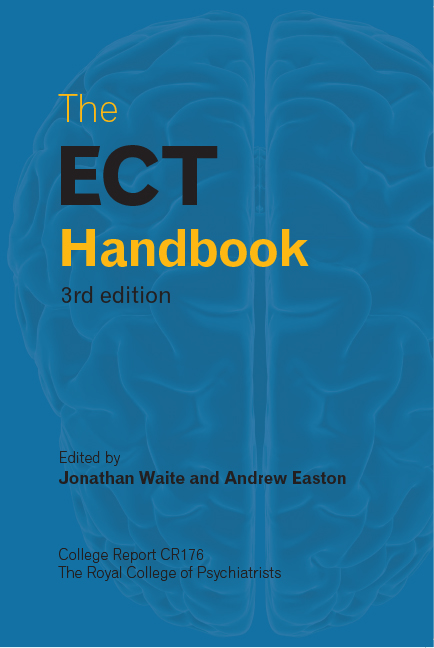Book contents
- Frontmatter
- Contents
- Abbreviations
- List of figures, tables and boxes
- List of contributors
- Preface
- Introduction: the role of ECT in contemporary psychiatry: Royal College of Psychiatrists’ Special Committee on ECT and Related Treatments
- 1 Mechanism of action of ECT
- 2 The ECT suite
- 3 Anaesthesia for ECT
- 4 ECT prescribing and practice
- 5 Psychotropic drug treatment during and after ECT
- 6 Monitoring a course of ECT
- 7 Non-cognitive adverse effects of ECT
- 8 Cognitive adverse effects of ECT
- 9 Dental issues related to ECT
- 10 Training, supervision and professional development: achieving competency
- 11 Nursing guidelines for ECT
- 12 Inspection of ECT clinics
- 13 Other brain stimulation treatments
- 14 The use of ECT in the treatment of depression
- 15 The use of ECT in the treatment of mania
- 16 The use of ECT in the treatment of schizophrenia and catatonia
- 17 The use of ECT in neuropsychiatric disorders
- 18 The use of ECT in people with intellectual disability
- 19 Safe ECT practice in people with a physical illness
- 20 ECT for older adults
- 21 The use of ECT as continuation or maintenance treatment
- 22 Consent, capacity and the law
- 23 Patients’ and carers’ perspectives on ECT
- Appendix I Out-patient declaration form
- Appendix II ECT competencies for doctors
- Appendix III Example of a job description for an ECT nurse specialist
- Appendix IV Example of a job description for an ECT nurse/ECT coordinator
- Appendix V Information for patients and carers
- Appendix VI Example of a consent form
- Appendix VII Useful contacts
- Appendix VIII Example of a certificate of incapacity
- Index
17 - The use of ECT in neuropsychiatric disorders
- Frontmatter
- Contents
- Abbreviations
- List of figures, tables and boxes
- List of contributors
- Preface
- Introduction: the role of ECT in contemporary psychiatry: Royal College of Psychiatrists’ Special Committee on ECT and Related Treatments
- 1 Mechanism of action of ECT
- 2 The ECT suite
- 3 Anaesthesia for ECT
- 4 ECT prescribing and practice
- 5 Psychotropic drug treatment during and after ECT
- 6 Monitoring a course of ECT
- 7 Non-cognitive adverse effects of ECT
- 8 Cognitive adverse effects of ECT
- 9 Dental issues related to ECT
- 10 Training, supervision and professional development: achieving competency
- 11 Nursing guidelines for ECT
- 12 Inspection of ECT clinics
- 13 Other brain stimulation treatments
- 14 The use of ECT in the treatment of depression
- 15 The use of ECT in the treatment of mania
- 16 The use of ECT in the treatment of schizophrenia and catatonia
- 17 The use of ECT in neuropsychiatric disorders
- 18 The use of ECT in people with intellectual disability
- 19 Safe ECT practice in people with a physical illness
- 20 ECT for older adults
- 21 The use of ECT as continuation or maintenance treatment
- 22 Consent, capacity and the law
- 23 Patients’ and carers’ perspectives on ECT
- Appendix I Out-patient declaration form
- Appendix II ECT competencies for doctors
- Appendix III Example of a job description for an ECT nurse specialist
- Appendix IV Example of a job description for an ECT nurse/ECT coordinator
- Appendix V Information for patients and carers
- Appendix VI Example of a consent form
- Appendix VII Useful contacts
- Appendix VIII Example of a certificate of incapacity
- Index
Summary
Electroconvulsive therapy has come a long way from Meduna's early theory of antagonism between epilepsy and schizophrenia to its application today in a range of neuropsychiatric disorders. Meduna (1935) postulated that epilepsy and psychosis were antagonistic, and that seizures therefore could be used to treat schizophrenia. Although this idea is in the broad sense no longer the basis for the use of ECT per se, the antagonism between seizures and behavioural disorders, also seen in another clinical setting, the so-called ‘forced normalisation and alternative psychosis’ of epilepsy (Krishnamoorthy & Trimble, 1999), is but one example of antagonisms in clinical neuropsychiatry. Other examples include: the creation of brain lesions to treat psychiatric conditions such as depression and obsessive– compulsive disorders (psychosurgery); the treatment of schizophrenia with antipsychotics, leading in turn to convulsions; the treatment of Parkinsonism with L-dopa, leading to improvement in the symptoms of that disease but also psychotic symptoms; and temporal lobectomy for patients with epilepsy, producing seizure freedom but also associated with psychiatric disorders such as depression and psychosis (Trimble, 1996).
Rooted in such a background of biological antagonism one would expect ECT to have established itself, or alternatively been eliminated, as a form of treatment in neurology and neuropsychiatry. In this chapter we examine the objective evidence for the use of ECT in neurological and neuropsychiatric disorders.
Parkinson's disease
Parkinson's disease is a neurodegenerative disorder characterised by akinesia, tremor, rigidity, postural instability and disturbances in mood and cognition. Its medical management is complicated by ‘on–off’ syndrome (abrupt changes in motor function, ranging from excessive dyskinetic movements to freezing instability) and debilitating (often drug-induced) psychotic symptoms, such as delusions and hallucinations (Kellner & Bernstein, 1993). Electroconvulsive therapy is known to enhance dopaminergic function in both animals and humans (see Chapter 1). The role of ECT as a treatment for Parkinson's disease, without some of these side-effects, indeed with improvement in some of the behavioural features, has been the source of considerable debate. Comprehensive reviews have looked at the efficacy of ECT as a modality of treatment in Parkinson's disease.
- Type
- Chapter
- Information
- The ECT Handbook , pp. 158 - 165Publisher: Royal College of PsychiatristsFirst published in: 2017

